Abstract
Retinoic acid prevents the decrease in epidermal Langerhans' cell (LC) density which occurs upon application of the tumour promotor 12-O-tetradecanoylphorbol 13-acetate (TPA) to murine skin. This occurred very rapidly, after only 1 week, and was still observed after 4 weeks of treatment. Retinoic acid alone increased the LC density, indicating that it could affect LC density independently of TPA. The induction of a contact sensitivity response which was inhibited by prior treatment with TPA due to the low LC density was also protected by retinoic acid. The anti-carcinogenic activity of retinoic acid is partially the result of its ability to inhibit tumour promotion. The loss of LC may be one of the important steps in tumour promotion as this would allow developing tumours to escape immune destruction. Our studies suggest that the ability of retinoic acid to suppress tumour promotion may be in part by protecting local antigen-presenting cells, thus allowing an immune response to be generated against tumours.
Full text
PDF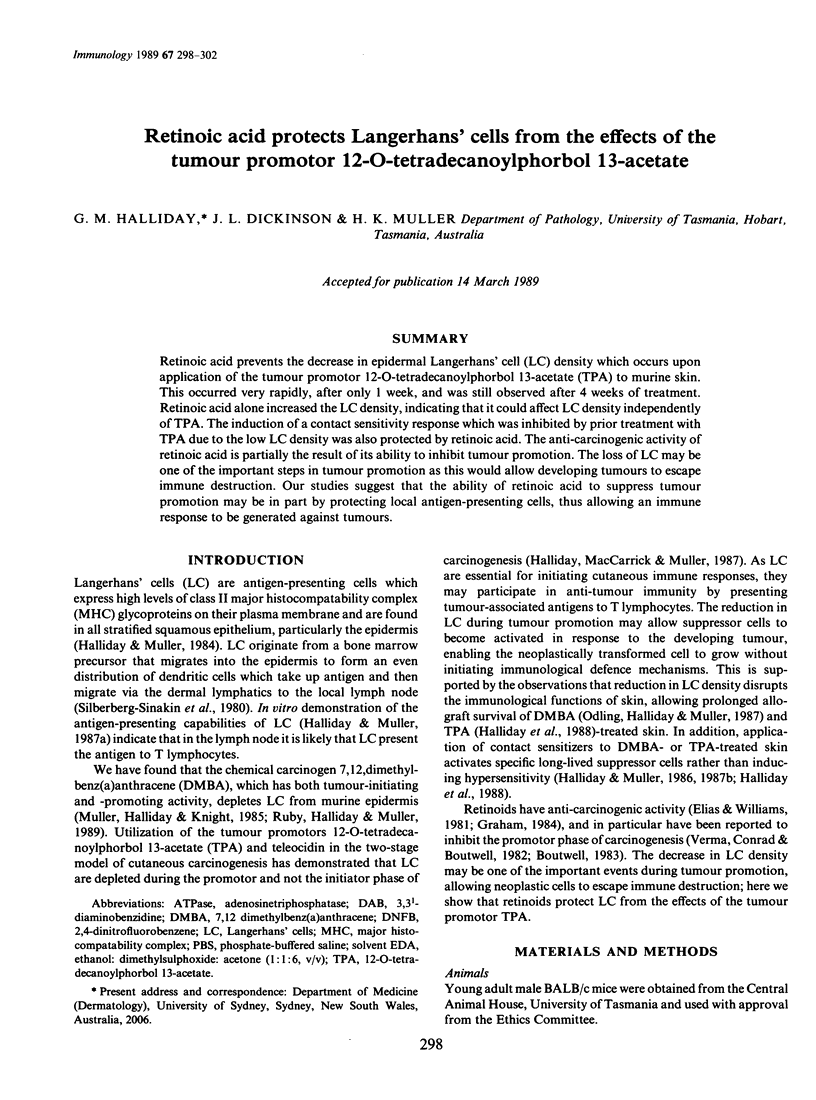
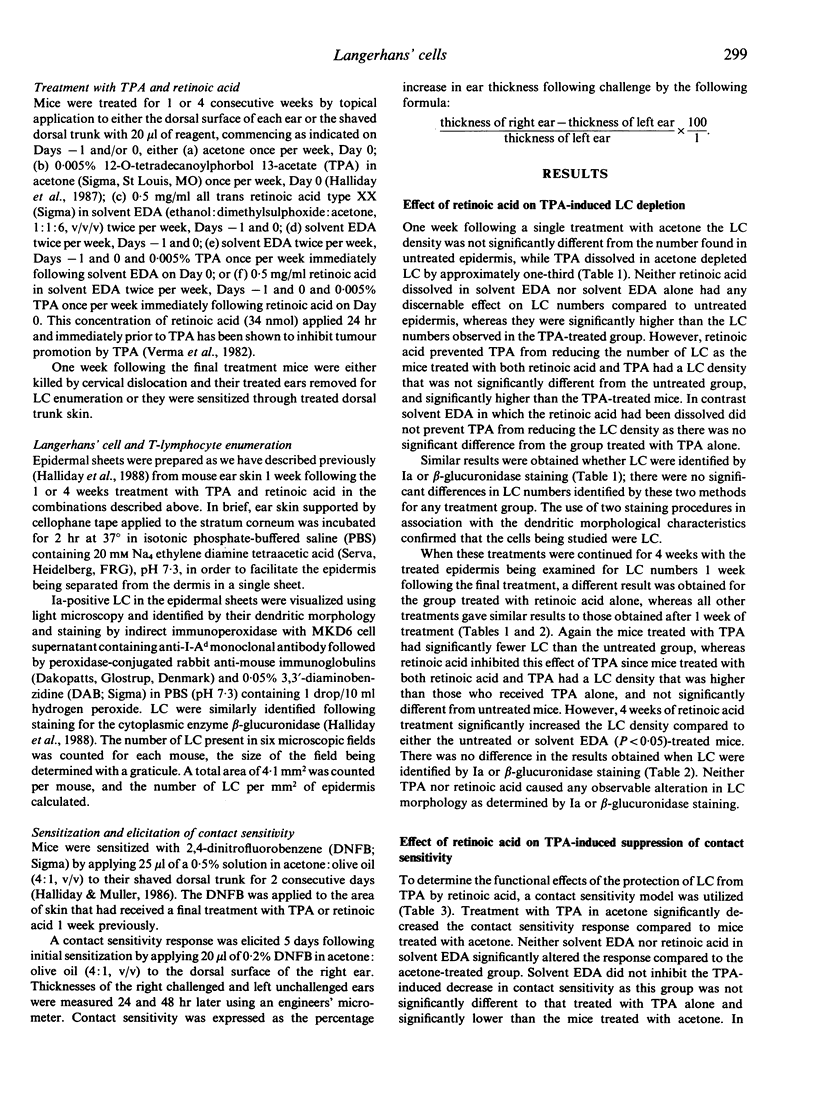
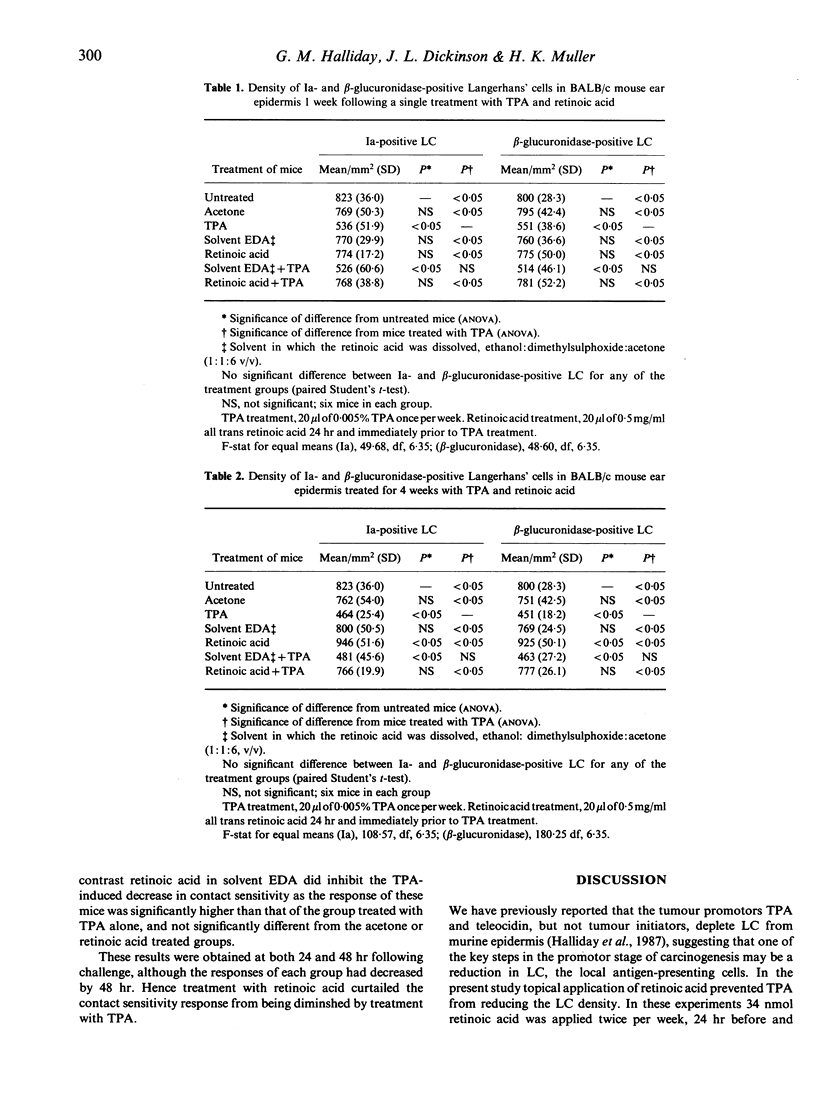
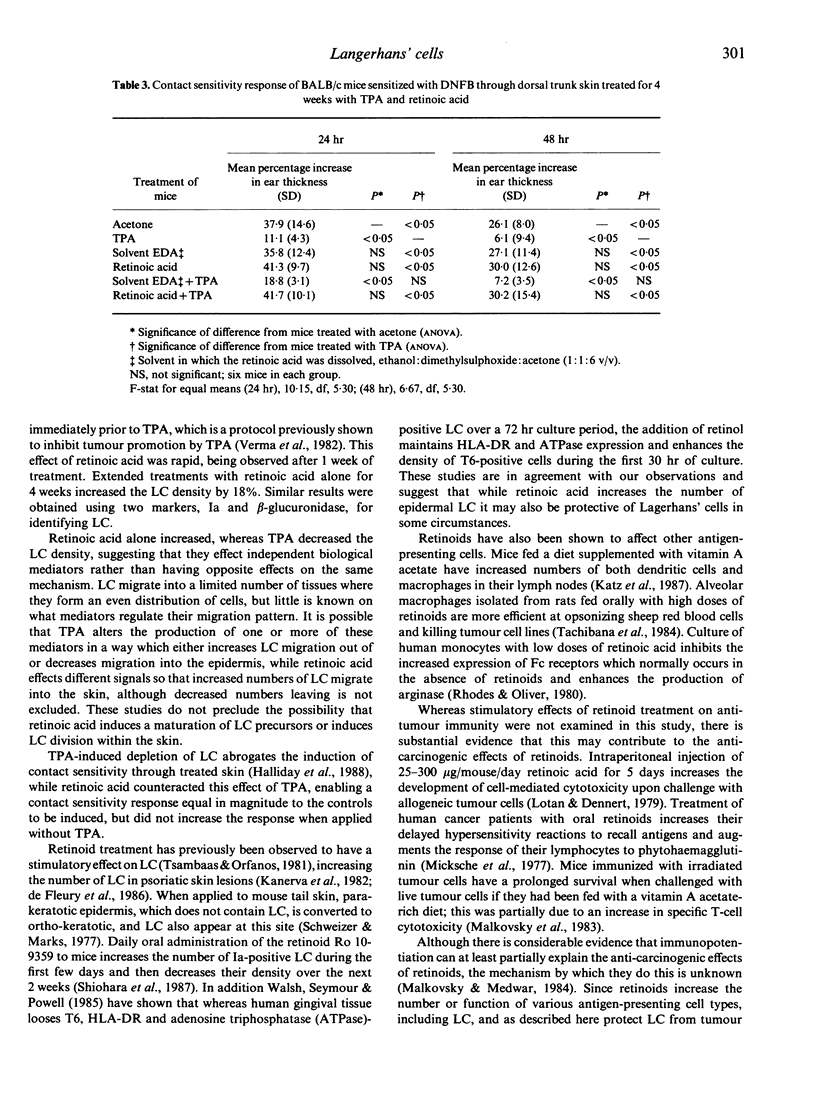
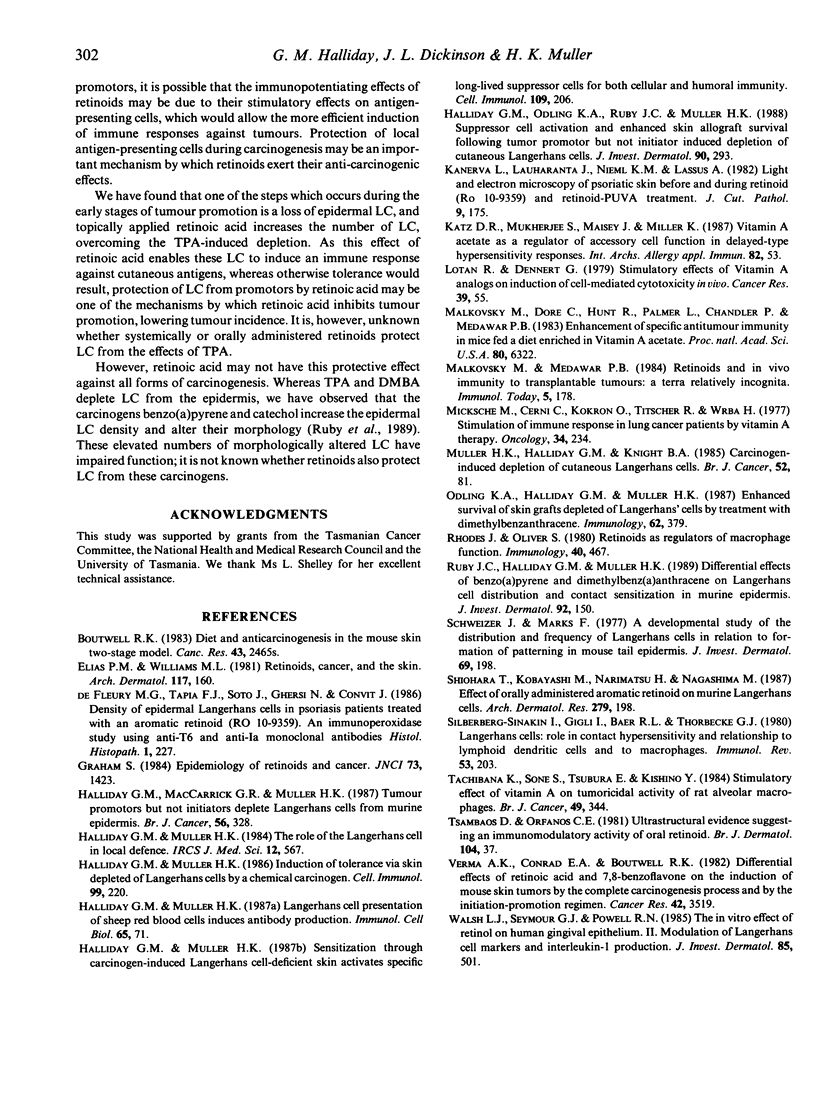
Selected References
These references are in PubMed. This may not be the complete list of references from this article.
- Elias P. M., Williams M. L. Retinoids, cancer, and the skin. Arch Dermatol. 1981 Mar;117(3):160–168. [PubMed] [Google Scholar]
- Graham S. Epidemiology of retinoids and cancer. J Natl Cancer Inst. 1984 Dec;73(6):1423–1428. [PubMed] [Google Scholar]
- Guzman de Fleury M., Tapia F. J., Soto J., Ghersi N., Convit J. Density of epidermal Langerhans cells in psoriasis patients treated with an aromatic retinoid (RO 10-9359). An immunoperoxidase study using anti-T6 and anti-Ia monoclonal antibodies. Histol Histopathol. 1986 Jul;1(3):227–234. [PubMed] [Google Scholar]
- Halliday G. M., Muller H. K. Induction of tolerance via skin depleted of Langerhans cells by a chemical carcinogen. Cell Immunol. 1986 Apr 15;99(1):220–227. doi: 10.1016/0008-8749(86)90230-3. [DOI] [PubMed] [Google Scholar]
- Halliday G. M., Muller H. K. Langerhans cell presentation of sheep red blood cells induces antibody production. Immunol Cell Biol. 1987 Feb;65(Pt 1):71–76. doi: 10.1038/icb.1987.8. [DOI] [PubMed] [Google Scholar]
- Halliday G. M., Muller H. K. Sensitization through carcinogen-induced Langerhans cell-deficient skin activates specific long-lived suppressor cells for both cellular and humoral immunity. Cell Immunol. 1987 Oct 1;109(1):206–221. doi: 10.1016/0008-8749(87)90305-4. [DOI] [PubMed] [Google Scholar]
- Halliday G. M., Odling K. A., Ruby J. C., Muller H. K. Suppressor cell activation and enhanced skin allograft survival after tumor promotor but not initiator induced depletion of cutaneous Langerhans cells. J Invest Dermatol. 1988 Mar;90(3):293–297. doi: 10.1111/1523-1747.ep12456077. [DOI] [PubMed] [Google Scholar]
- Kanerva L., Lauharanta J., Niemi K. M., Lassus A. Light and electron microscopy of psoriatic skin before and during retinoid (Ro 10-9359) and retinoid-PUVA treatment. J Cutan Pathol. 1982 Jun;9(3):175–188. doi: 10.1111/j.1600-0560.1982.tb01054.x. [DOI] [PubMed] [Google Scholar]
- Katz D. R., Mukherjee S., Maisey J., Miller K. Vitamin A acetate as a regulator of accessory cell function in delayed-type hypersensitivity responses. Int Arch Allergy Appl Immunol. 1987;82(1):53–56. doi: 10.1159/000234289. [DOI] [PubMed] [Google Scholar]
- Lotan R., Dennert G. Stimulatory effects of vitamin A analogs on induction of cell-mediated cytotoxicity in vivo. Cancer Res. 1979 Jan;39(1):55–58. [PubMed] [Google Scholar]
- Malkovský M., Doré C., Hunt R., Palmer L., Chandler P., Medawar P. B. Enhancement of specific antitumor immunity in mice fed a diet enriched in vitamin A acetate. Proc Natl Acad Sci U S A. 1983 Oct;80(20):6322–6326. doi: 10.1073/pnas.80.20.6322. [DOI] [PMC free article] [PubMed] [Google Scholar]
- Micksche M., Cerni C., Kokron O., Titscher R., Wrba H. Stimulation of immune response in lung cancer patients by vitamin A therapy. Oncology. 1977;34(5):234–238. doi: 10.1159/000225231. [DOI] [PubMed] [Google Scholar]
- Odling K. A., Halliday G. M., Muller H. K. Enhanced survival of skin grafts depleted of Langerhans' cells by treatment with dimethylbenzanthracene. Immunology. 1987 Nov;62(3):379–385. [PMC free article] [PubMed] [Google Scholar]
- Rhodes J., Oliver S. Retinoids as regulators of macrophage function. Immunology. 1980 Jul;40(3):467–472. [PMC free article] [PubMed] [Google Scholar]
- Ruby J. C., Halliday G. M., Muller H. K. Differential effects of benzo[a]pyrene and dimethylbenz[a]-anthracene on Langerhans cell distribution and contact sensitization in murine epidermis. J Invest Dermatol. 1989 Feb;92(2):150–155. doi: 10.1111/1523-1747.ep12276661. [DOI] [PubMed] [Google Scholar]
- Schweizer J., Marks F. A developmental study of the distribution and frequency of Langerhans cells in relation to formation of patterning in mouse tail epidermis. J Invest Dermatol. 1977 Aug;69(2):198–204. doi: 10.1111/1523-1747.ep12506298. [DOI] [PubMed] [Google Scholar]
- Shiohara T., Kobayashi M., Narimatsu H., Nagashima M. Effect of orally administered aromatic retinoid on murine Langerhans cells. Arch Dermatol Res. 1987;279(3):198–203. doi: 10.1007/BF00413258. [DOI] [PubMed] [Google Scholar]
- Silberberg-Sinakin I., Gigli I., Baer R. L., Thorbecke G. J. Langerhans cells: role in contact hypersensitivity and relationship to lymphoid dendritic cells and to macrophages. Immunol Rev. 1980;53:203–232. doi: 10.1111/j.1600-065x.1980.tb01045.x. [DOI] [PubMed] [Google Scholar]
- Tsambaos D., Orfanos C. E. Ultrastructural evidence suggesting an immunomodulatory activity of oral retinoid. Its effect on dermal components in psoriasis. Br J Dermatol. 1981 Jan;104(1):37–45. doi: 10.1111/j.1365-2133.1981.tb01709.x. [DOI] [PubMed] [Google Scholar]
- Verma A. K., Conrad E. A., Boutwell R. K. Differential effects of retinoic acid and 7,8-benzoflavone on the induction of mouse skin tumors by the complete carcinogenesis process and by the initiation-promotion regimen. Cancer Res. 1982 Sep;42(9):3519–3525. [PubMed] [Google Scholar]
- Walsh L. J., Seymour G. J., Powell R. N. The in vitro effect of retinol on human gingival epithelium. II. Modulation of Langerhans cell markers and interleukin-1 production. J Invest Dermatol. 1985 Dec;85(6):501–506. doi: 10.1111/1523-1747.ep12277300. [DOI] [PubMed] [Google Scholar]


